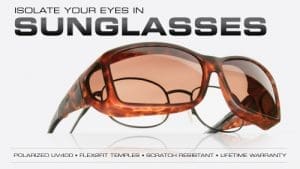Harmful Effects of Ultra-violet and Blue Light Ultra-violet light is that portion of the spectrum of invisible light below 286nm to 400nm, and is generally understood to be harmful to the eye, possibly leading to cataracts and other eye diseases such as age-related macular degeneration (AMD). Retinal damage is the most important hazard from light. The three types of retinal damage are structural, thermal and photochemical. The type of damage depends on the wavelength, power level and exposure time.
Sources of UV Light
While the primary source of UV light is the sun, other sources include welder’s flash, video display terminals, fluorescent lighting, highintensity mercury vapor lamps (for night sports and high-crime areas), and xenon arc lamps.
Types of UV Light
UV light is divided into three segments, which are designated as A, B, and C, described briefly below in order from least harmful to most harmful to the eye.
- UVC (below 286nm) is effectively filtered by the earth’s ozone layer.
- UVB (286-320nm) is that solar energy which is the cause of sunburn and snow blindness and is absorbed by the cornea.
- UVA (320-400nm) is that part of the invisible spectrum of particular concern to eye care professionals. It is the most damaging of UV radiation, and it is the radiation transmitted to the crystalline lens of the human eye.
![uv_eye2[1]](https://b2104283.smushcdn.com/2104283/wp-content/uploads/2016/05/uv_eye21-300x84.jpg?lossy=2&strip=1&webp=1)
Melanin as Protection from Harmful UV Light
Researchers have identified melanin as the substance in the skin, hair and eyes that absorbs harmful UV and blue light. It is the body’s natural sunscreen protection. Higher amounts of melanin afford greater protection against damaging light rays, but melanin is lost as we age. By age 65, about half of the protection is gone, increasing susceptibility to eye disease such as macular degeneration. The Schepens Eye Institute reports that “the blue rays of the spectrum seem to accelerate AMD more than other rays of the spectrum.” Very bright lights such as sunlight or its reflection in the ocean or desert may worsen macular degeneration. The Institute recommends that sunglasses protect against both blue/violet and UV light.
By including synthetic melanin in our sunglasses, we may be compensating for the melanin lost as we age. With such sunglasses, the colors are filtered in proportion to their damage potential, and thus the danger of macular degeneration may be reduced. Many optical shops that sell prescription eyewear now have melanin lenses available. For an online source, see Melanin Products from PhotoProtective Technologies, the inventors of melanin lenses.
Who needs protection from harmful UV light? – Those who work or play in the sun. For example, construction workers, farmers, truck drivers, sports participants and spectators, police officers, skiers, lifeguards, and beach goers.
Anyone else? – Those taking medications! There are many photosensitizing drugs on the market today, including certain tranquilizers, diuretics, oral contraceptives, antibiotics, anti-diabetic and anti-hypertensive medications, and even artificial sweeteners such as cyclamates.
Guidelines on UV Protective Eyewear
AMDF Web site visitors are advised to protect their eyes from potentially harmful UV light. Not only is harmful UV light present on sunny days, it is also present on overcast or hazy days. UV protection is available for clear lenses as well as sunglasses. The UV protection that is available is an invisible coating that doesn’t change the color of the eyeglass lens.
Misleading claims about certain glasses providing UV protection can be easily confusing to consumers. A pair of glasses might be labeled UV absorbent, for example, but the label might not indicate exactly how much UVA and UVB rays are blocked. Sunglasses should be labeled UV 400. It is recommended that you protect yourself from UV radiation up to 400 nanometers, which extends into part of the visible spectrum to ensure complete blockage of ultraviolet light. This is what distinguishes “cheap” sunglasses from more expensive ones.

Ask your eyecare professional if your eyewear has been treated for UV light protection. He or she will be glad to answer your questions and ensure that your eyes are adequately protected from UV radiation damage. Melanin lenses are now readily available at most optical shops which sell prescription eyewear.
Blue Light
The scientific evidence implicates blue light as a risk factor in contributing to the onset or progression of macular degeneration, as well as other eye diseases such as cataracts. However, the blue light emitted from the sun and the blue light emitted from electronic devices are significantly different. While most of the research agrees that UV blocking sunglasses are an important protective measure against sunlight exposure, the research on blue light emitted from electronic devices is contradictory and inconclusive.
Studies such as this one https://www.nature.com/articles/s41598-018-28254-8#Abs1 verify that blue light can cause damage at greater intensities, but the findings of such studies tend to get extrapolated by the press or marketing campaigns to implicate all blue light as damaging, including that emitted from electronic devices. However, this study, and others, did not show effects on living eye tissue. Furthermore, this, and previous research, shows damaging effects only when the light energy is 3 microwatts or greater. The light energy emitted from electronic devices is typically no greater than 1 microwatt.
We can’t say for sure there isn’t a cumulative effect of lower energy blue light; to date there is no clear evidence to suggest it.
But should people wear blue light blocking lenses for electronic use “just in case?”
A 2017 study by the Centre for Applied Vision Research of London and the Department of Optometry and Vision Sciences of The University of Melbourne, Australia found no evidence that blue light blocking glasses offered any significant protection against eye fatigue, sleep quality, or macular damage. https://www.ncbi.nlm.nih.gov/pubmed/29044670
AMDF’s position is that people should definitely wear UV protective sunglasses for sun exposure, but right now there isn’t much evidence to support wearing blue light blocking lenses for everyday electronics use. Little evidence currently exists to suggest either that this level of blue light exposure is damaging to the eye or that the current glasses on the market offer any significant protection. That said, it’s always best to consult your eye-care professional and to decide what’s best for you.
Some blue light is healthy for the eyes, and even required for visual development in children. Studies continue on long-term exposure, and as science and technology advance our knowledge, we will keep you updated.

